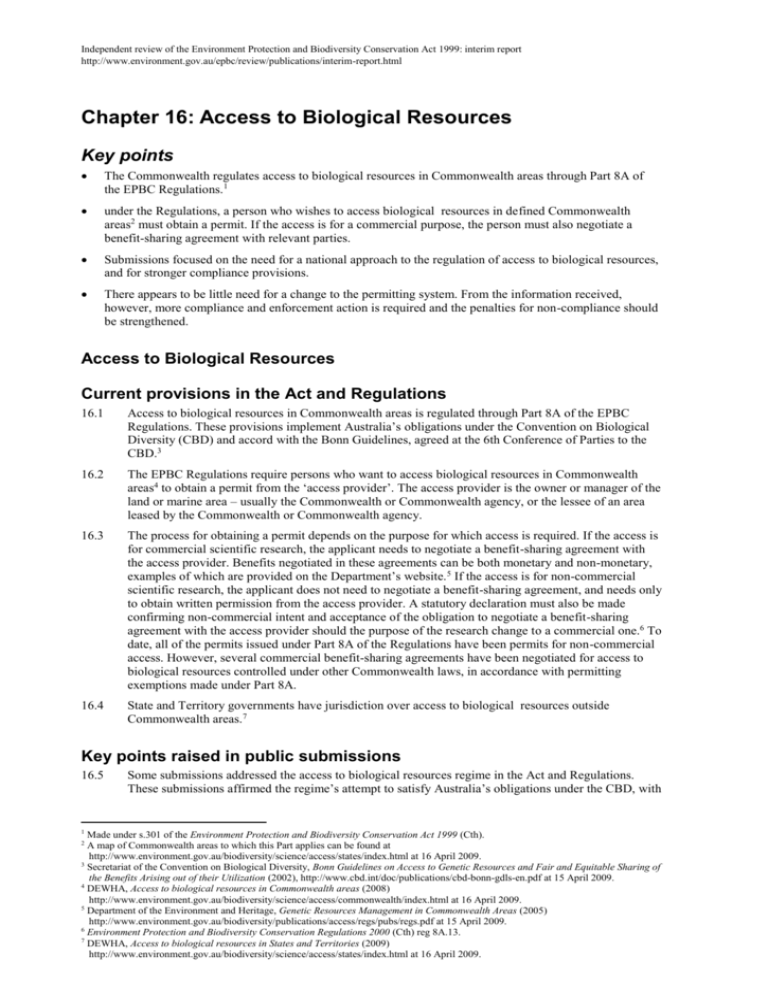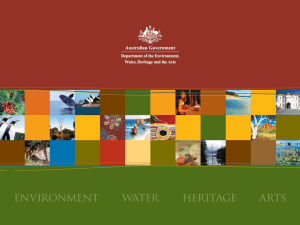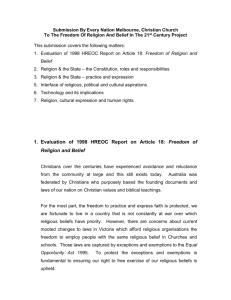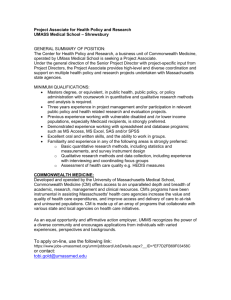Access to biological resources - Department of the Environment
advertisement

Independent review of the Environment Protection and Biodiversity Conservation Act 1999: interim report http://www.environment.gov.au/epbc/review/publications/interim-report.html Chapter 16: Access to Biological Resources Key points The Commonwealth regulates access to biological resources in Commonwealth areas through Part 8A of the EPBC Regulations.1 under the Regulations, a person who wishes to access biological resources in defined Commonwealth areas2 must obtain a permit. If the access is for a commercial purpose, the person must also negotiate a benefit-sharing agreement with relevant parties. Submissions focused on the need for a national approach to the regulation of access to biological resources, and for stronger compliance provisions. There appears to be little need for a change to the permitting system. From the information received, however, more compliance and enforcement action is required and the penalties for non-compliance should be strengthened. Access to Biological Resources Current provisions in the Act and Regulations 16.1 Access to biological resources in Commonwealth areas is regulated through Part 8A of the EPBC Regulations. These provisions implement Australia’s obligations under the Convention on Biological Diversity (CBD) and accord with the Bonn Guidelines, agreed at the 6th Conference of Parties to the CBD.3 16.2 The EPBC Regulations require persons who want to access biological resources in Commonwealth areas4 to obtain a permit from the ‘access provider’. The access provider is the owner or manager of the land or marine area – usually the Commonwealth or Commonwealth agency, or the lessee of an area leased by the Commonwealth or Commonwealth agency. 16.3 The process for obtaining a permit depends on the purpose for which access is required. If the access is for commercial scientific research, the applicant needs to negotiate a benefit-sharing agreement with the access provider. Benefits negotiated in these agreements can be both monetary and non-monetary, examples of which are provided on the Department’s website. 5 If the access is for non-commercial scientific research, the applicant does not need to negotiate a benefit-sharing agreement, and needs only to obtain written permission from the access provider. A statutory declaration must also be made confirming non-commercial intent and acceptance of the obligation to negotiate a benefit-sharing agreement with the access provider should the purpose of the research change to a commercial one.6 To date, all of the permits issued under Part 8A of the Regulations have been permits for non-commercial access. However, several commercial benefit-sharing agreements have been negotiated for access to biological resources controlled under other Commonwealth laws, in accordance with permitting exemptions made under Part 8A. 16.4 State and Territory governments have jurisdiction over access to biological resources outside Commonwealth areas.7 Key points raised in public submissions 16.5 1 Some submissions addressed the access to biological resources regime in the Act and Regulations. These submissions affirmed the regime’s attempt to satisfy Australia’s obligations under the CBD, with Made under s.301 of the Environment Protection and Biodiversity Conservation Act 1999 (Cth). A map of Commonwealth areas to which this Part applies can be found at http://www.environment.gov.au/biodiversity/science/access/states/index.html at 16 April 2009. 3 Secretariat of the Convention on Biological Diversity, Bonn Guidelines on Access to Genetic Resources and Fair and Equitable Sharing of the Benefits Arising out of their Utilization (2002), http://www.cbd.int/doc/publications/cbd-bonn-gdls-en.pdf at 15 April 2009. 4 DEWHA, Access to biological resources in Commonwealth areas (2008) http://www.environment.gov.au/biodiversity/science/access/commonwealth/index.html at 16 April 2009. 5 Department of the Environment and Heritage, Genetic Resources Management in Commonwealth Areas (2005) http://www.environment.gov.au/biodiversity/publications/access/regs/pubs/regs.pdf at 15 April 2009. 6 Environment Protection and Biodiversity Conservation Regulations 2000 (Cth) reg 8A.13. 7 DEWHA, Access to biological resources in States and Territories (2009) http://www.environment.gov.au/biodiversity/science/access/states/index.html at 16 April 2009. 2 one submission describing the regulatory regime in Part 8A as a ‘bold attempt to satisfy Australia’s obligations under the [CBD]’.8 16.6 However, submissions believed that there were areas which could be improved. For example, it was argued that the current regime does not appropriately value biological resources, and that the remedies for breaches of the permit system were inadequate. It was also argued that the Regulations fail to consider appropriately the traditional knowledge of Indigenous landholders and that inconsistencies between the Commonwealth and State and Territory regimes requires resolution. 16.2.3 Discussion of key points Nationally consistent approach to access to biological resources 16.7 In 2002, the Natural Resource Management Ministerial Council, comprised of Australian Federal, State and Territory Ministers and New Zealand Government Ministers responsible for primary industries, natural resources, environment and water policy, endorsed the Nationally consistent approach for access to and the utilisation of Australia’s native genetic and biochemical resources (Nationally Consistent Approach)9. This document was designed to ensure that ‘the social and economic benefits of the use of genetic material and products derived from Australia’s biodiversity accrue to Australia.’ 10 Adoption of Part 8A of the EPBC Regulations was the Australian Government’s response to that document. 16.8 The Nationally Consistent Approach intended that similar access to biological resources regimes would be enacted in each Australian jurisdiction. However, this intention has not yet been realised. The different requirements in each jurisdiction are a potential source of confusion for permit applicants and land managers, and create an unnecessary need for multiple permits where bioprospecting ventures occur across jurisdictional boundaries. While it is outside the scope of this review to suggest changes to the provisions of State or Territory legislation, the adoption of the Nationally Consistent Approach (i.e. a single-form approach with an established set of criteria and nationally standard terms) in all Australian jurisdictions to regulate access to biological resources throughout Australia would reduce uncertainty in this area. Use of traditional knowledge 16.9 The use of Traditional Knowledge associated with genetic resources raises significant issues, including aspects related to intellectual property, particularly in the context of ongoing negotiations under the CBD and the World Intellectual Property Organization. These issues are discussed further in Chapter 17. Benefit-sharing agreements 16.10 As noted above, only permits for commercial research require the negotiation of a benefit-sharing agreement. To date, only non-commercial permits had been issued. It was queried whether this meant that access of biological resources is only occurring on a non-commercial basis or perhaps commercial ventures are being disguised as non-commercial ones to avoid negotiation of benefit-sharing agreements. No information received during the review supports the latter conclusion. 16.11 The Regulations require holders of permits for non-commercial use to negotiate a benefit-sharing agreement when the purpose of the access shifts to a commercial purpose. 11 There may therefore be no need to add to the provisions already in the regulation. Better enforcement of these provisions (discussed below) may assist to deter against commercial ventures being disguised as non-commercial ones. Greater awareness of the provisions of Part 8A may also increase the number and type of permit applications made. 8 Submission 137: Dr Matthew Rimmer p.42. Natural Resource Management Ministerial Council, Nationally consistent approach for access to and the utilisation of Australia’s native genetic and biochemical resources (2002) http://www.environment.gov.au/biodiversity/publications/access/nca/pubs/nca.pdf at 15 April 2009. 10 National Strategy for the Conservation of Australia’s Biological Diversity Objective 2.8 cited in the Nationally Consistent Approach, p.2. 11 Environment Protection and Biodiversity Conservation Regulations 2000 (Cth) reg.8A.13. 9 Independent review of the Environment Protection and Biodiversity Conservation Act 1999: interim report http://www.environment.gov.au/epbc/review/publications/interim-report.html Compliance and enforcement of Part 8a 16.12 Submissions argued that the current compliance and enforcement regime applicable to access to biological resources is inadequate, particularly with respect to the penalties for non-compliance. 16.13 Dr Matthew Rimmer drew attention to the fact that: remedies available for a breach of the access to genetic resources scheme are capped because of the reliance upon regulations, rather than legislation. Brad Sherman comments that the access to genetic resources scheme does not deal with the situation where biological material is passed to a third party in breach of contract, or where the biological material is obtained through biopiracy and then sold to a third party. He comments: …These potential problems are exacerbated by the fact that it is possible to imagine the situation where a company makes a calculated decision to collect biological samples without an access permit. While the fine of A$5,500 and the adverse publicity may provide some disincentive against this happening, a company may decide that is outweighed by the legal costs and by the moneys that they would have to pay under a benefit sharing agreement with the access provider.12 However, the Department … is unable to impose greater penalties against individuals or companies who would flout this regime. Notably, the paltry maximum fine of A$5,500 is unable to be raised any higher without legislative amendment.13 16.14 It was suggested during public consultations that the offence provisions currently in Part 8A be inserted into the Act in order to strengthen the penalties applicable to breaches of the provisions of Part 8A. It is the preliminary view of this review is that it would be appropriate to move the offence provisions of Part 8A into the Act so that the penalties are commensurate with penalties for other offences in the Act and are sufficiently high to deter non-compliance with the access to biological resources regime. 16.15 The Queensland Biodiscovery Act 2004 is an example of legislation with much higher financial penalties for non-compliance with their access to biological resources regime, and the possibility of imprisonment for individuals convicted under the provisions of that Act. 14 16.16 As noted above, it is desirable for jurisdictions across Australia to act consistently with respect to accessing biological resources. The preliminary view is that Australian jurisdictions should consider further a national approach to regulation of access to biological resources. In addition, the provisions of Part 8A may need to be enforced better, so as to increase compliance with the permit system. Brad Sherman ‘Regulating Access And use Of Genetic Resources: Intellectual Property Law And Biodiscovery’ (2003) 25 European Intellectual Property Review 7, pp.301-308 cited in Submission 137: Dr Matthew Rimmer, p.42. 13 Submission 137: Dr Matthew Rimmer, p.42. 14 Biodiscovery Act 2004 (Qld) Part 7. 12







